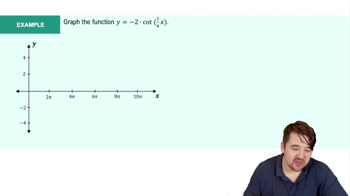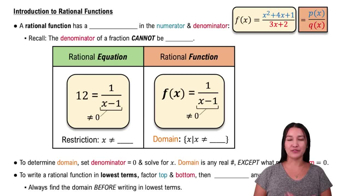Table of contents
- 0. Functions7h 52m
- Introduction to Functions16m
- Piecewise Functions10m
- Properties of Functions9m
- Common Functions1h 8m
- Transformations5m
- Combining Functions27m
- Exponent rules32m
- Exponential Functions28m
- Logarithmic Functions24m
- Properties of Logarithms34m
- Exponential & Logarithmic Equations35m
- Introduction to Trigonometric Functions38m
- Graphs of Trigonometric Functions44m
- Trigonometric Identities47m
- Inverse Trigonometric Functions48m
- 1. Limits and Continuity2h 2m
- 2. Intro to Derivatives1h 33m
- 3. Techniques of Differentiation3h 18m
- 4. Applications of Derivatives2h 38m
- 5. Graphical Applications of Derivatives6h 2m
- 6. Derivatives of Inverse, Exponential, & Logarithmic Functions2h 37m
- 7. Antiderivatives & Indefinite Integrals1h 26m
1. Limits and Continuity
Finding Limits Algebraically
Problem 81b
Textbook Question
Find the vertical asymptotes. For each vertical asymptote x=a, analyze lim x→a^− f(x) and lim x→a^+f(x).
f(x)=cos x+2√x / √x.
 Verified step by step guidance
Verified step by step guidance1
<Step 1: Simplify the function.> Start by simplifying the given function \( f(x) = \frac{\cos x + 2\sqrt{x}}{\sqrt{x}} \). This can be rewritten as \( f(x) = \frac{\cos x}{\sqrt{x}} + 2 \).
<Step 2: Identify potential vertical asymptotes.> Vertical asymptotes occur where the denominator is zero and the numerator is not zero. Here, the denominator \( \sqrt{x} \) is zero when \( x = 0 \).
<Step 3: Analyze the limit as \( x \to 0^- \).> Since \( \sqrt{x} \) is not defined for negative \( x \), we only consider the limit from the right, \( x \to 0^+ \).
<Step 4: Analyze the limit as \( x \to 0^+ \).> Evaluate \( \lim_{x \to 0^+} \frac{\cos x}{\sqrt{x}} + 2 \). As \( x \to 0^+ \), \( \sqrt{x} \to 0^+ \) and \( \cos x \to 1 \), so the term \( \frac{\cos x}{\sqrt{x}} \) approaches infinity.
<Step 5: Conclude the behavior at the asymptote.> Since \( \lim_{x \to 0^+} f(x) = \infty \), there is a vertical asymptote at \( x = 0 \). The function approaches infinity as \( x \to 0^+ \).
Recommended similar problem, with video answer:
 Verified Solution
Verified SolutionThis video solution was recommended by our tutors as helpful for the problem above
Video duration:
3mPlay a video:
Was this helpful?
Key Concepts
Here are the essential concepts you must grasp in order to answer the question correctly.
Vertical Asymptotes
Vertical asymptotes occur in a function when the function approaches infinity or negative infinity as the input approaches a certain value from either the left or the right. This typically happens when the denominator of a rational function approaches zero while the numerator remains non-zero. Identifying vertical asymptotes is crucial for understanding the behavior of the function near those points.
Recommended video:

Introduction to Cotangent Graph Example 1
Limits
Limits are fundamental in calculus, representing the value that a function approaches as the input approaches a certain point. In the context of vertical asymptotes, evaluating the left-hand limit (lim x→a^− f(x)) and the right-hand limit (lim x→a^+ f(x)) helps determine the behavior of the function as it nears the asymptote. This analysis is essential for understanding how the function behaves around points of discontinuity.
Recommended video:

One-Sided Limits
Rational Functions
A rational function is a ratio of two polynomials, which can exhibit vertical asymptotes when the denominator equals zero. In the given function f(x) = (cos x + 2√x) / √x, the denominator √x must be analyzed to find points where it becomes zero, leading to potential vertical asymptotes. Understanding the structure of rational functions is key to identifying their asymptotic behavior.
Recommended video:

Intro to Rational Functions

 5:21m
5:21mWatch next
Master Finding Limits by Direct Substitution with a bite sized video explanation from Callie
Start learningRelated Videos
Related Practice







